Ko Tainui Te Waka
Ko Taupiri Te Maunga
Ko Waikato Te Awa
Ko Waikato Te Iwi
Ko Pōtatau Te Wherowhero Te Tangata
He Piko, He Taniwha
He Piko, He Taniwha
Waikato Taniwharau

Taupiri Maunga
The tangata whenua, in their role as kaitiaki (guardians), are pivotal to the success of the Huntly section of the Waikato Expressway. They have been involved with various plans to build a road since 1993. Taupiri Maunga is a sacred mountain to Waikato-Tainui and is defined in the tribal pepeha (tribal identity) written above.
Tangata whenua have a relationship with the mountains, rivers, lakes and environment in general, which are indivisible and have defined Māori as the kaitiaki for this area since before the arrival of Europeans. The maunga (mountain), which is the final resting place for many tribal members who connect directly to Waikato, is also the final resting place for Te Whare Kaahui Ariki (Māori Royal Family). The proposed alignment raises interest within the wider tribe and the role of kaitiaki to ensure that the pre-eminence of the maunga and envaironment is preserved.
Rāhui Pōkeka (Huntly) is also rich in history and the proposed alignment aims to ensure that history is captured and preserved for future generations. Prior to European settlement, Kimihia was once a thriving well established papakainga (village). As generations and knowledge holders of this history have faded away, it is critical to ensure the cultural heritage of wahi tapu (sites of significance) is retained. Rāhui Pōkeka is formed around the natural elements of the environment - for this reason alone the recording and documenting of this maatauranga (traditional knowledge) is essential.
Waikato-Tainui, tangata whenua and the Transport Agency are committed to working together to ensure that the interests of all parties are respected throughout the course of this project and the entire Waikato Expressway, a commitment which is based on the principles of good faith and meaningful relationships.Waikato-Tainui has facilitated a process to actively involve its marae and hapu (sub-tribes) within various sections of the
Waikato Expressway
The establishment of the Tangata Whenua Working Group has ensured local marae and hapu representation is acknowledged and provided for during the course of this project, a process that acknowledges each other’s views and seeks to fulfil the fundamental objectives of co-management.
The role of tangata whenua is diverse and traverses all elements of this project including the completion of a Kaitiaki Environmental Impact Assessment. This explores how key sites of significance need to be preserved, what measures the Transport Agency may need to explore in order to preserve the cultural and heritage elements of this project, and how all stakeholders can ensure the environment is preserved. Tangata whenua have been involved in all stages of the project so far, and will do so until the road is officially opened.
